Cathedral of Córdoba, Argentina
The Cathedral of Córdoba (Our Lady of the Assumption; Spanish: Nuestra Señora de la Asunción) is the central church of the Roman Catholic Archdiocese of Córdoba, Argentina, and the oldest church in continuous service in Argentina.
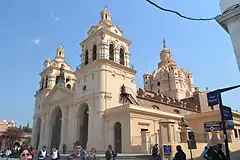
(the Córdoba Cathedral).
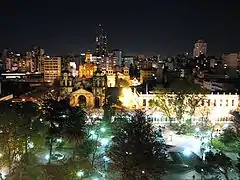
Overview
Construction on the original church, the Iglesia de Nuestra Señora de la Asunción began in 1582. Its early works were planned by architect Nicolás de Dios, public works director Gregorio Ferreira, and master mason Juan Rodríguez, who employed mostly indigenous artisans and laborers. Beams and rafters were planned by Mateo Domínguez, and Hernando Álvarez designed and oversaw installation of the roof's 30,000 mission roof tiles.
Much of the initial structure was lost in a 1677 collapse. Ricardo González Merguete, a Jesuit architect, was commissioned to reinitiate works, and designed the new structural plans. Italian Gian Battista Primoli provided the floor plan, a latin cross outline based on that of the Jesuit Church of the Gesù, in Rome.
_Siglo_XIX.jpg.webp)
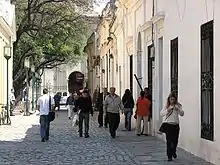
The incomplete church was inaugurated in 1709. Further additions included the cupola, designed by Franciscan Friar Vicente Muñoz, the Spanish Baroque façade and the Neoclassical portico were designed in 1729 by Italian architect Andrea Blanqui (who would design a number of other churches in what today is Argentina). The cathedral was consecrated by Bishop José Antonio de San Alberto in 1784, and the twin campaniles were completed in 1787. The cathedral is separated from the Córdoba Cabildo (colonial town hall, inaugurated in 1786), by the Santa Catalina Promenade.
The narthex of the cathedral, and adjacent crypts, would be the burial site for a number of prominent figures in the history of Córdoba Province, and the nation's. Some of these include General José María Paz (and his wife, Margarita Weild), Dean Gregorio Funes, Bishop Hernando de Trejo y Sanabria (the first rector of the University of Córdoba, the oldest in Argentina), and Friar Mamerto Esquiú.
The ornate interior, overlooked by the sterling silver altar crafted in Colonial Peru, also includes a church tabernacle donated to the cathedral in 1804, as well as an extensive collection of silver and gold votive offerings. The interior was later decorated with frescoes and murals painted in the early years of the 20th century by Emilio Caraffa, Carlos Camilloni, and Manuel Cardeñosa; a cast iron monument, Cristo Redentor (Christ the Redeemer) was installed above the portico in 1901.
The Cathedral of Córdoba was declared a National Historic Monument in 1941, and underwent extensive restoration works from 2007 to 2009.
Gallery
_2010-03-15_01.jpg.webp) Lighting installed during recent restoration
Lighting installed during recent restoration.JPG.webp) Altar
Altar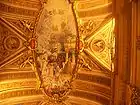 Baroque ceiling
Baroque ceiling Tomb of Gen. José María Paz
Tomb of Gen. José María Paz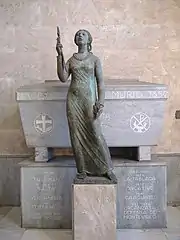 Tomb of Margarita Weild
Tomb of Margarita Weild Tomb of Dean Gregorio Funes
Tomb of Dean Gregorio Funes
References
https://www.britannica.com/place/Cordoba-Argentina* Catedrales Católicas del Mundo (in Spanish)
- La Voz: Luces y fachadas renovadas en la Catedral (in Spanish)
- Invitarte: Museos de Córdoba (in Spanish)